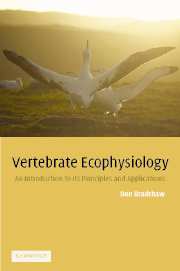Book contents
- Frontmatter
- Contents
- Introduction
- 1 Homeostasis: a fundamental organising paradigm in ecophysiology
- 2 Stress: the concept and the reality
- 3 Basic methods used in ecophysiological studies
- 4 Turnover methodology: theory and practice
- 5 Case studies of stress: incidence and intensity
- 6 Survival in deserts
- 7 Torpor and hibernation in cold climates
- 8 Marine birds and mammals
- 9 Conclusion
- Appendix 1 Population estimation methods
- Appendix 2 Estimation of food intake in Tiliqua rugosa
- Appendix 3 Simultaneous measurement of sodium and potassium concentration in plasma or urine using the IL 143 digital flame photometer
- Appendix 4 Determination of plasma urea nitrogen
- Appendix 5 Radioimmunoassay of testosterone in plasma
- Appendix 6 Preparation of ‘stripped plasma’
- Appendix 7 Radioimmunoassay of testosterone in faeces
- Appendix 8 The comparative method
- Appendix 9 Basic turnover equations
- References
- Index
Appendix 7 - Radioimmunoassay of testosterone in faeces
Published online by Cambridge University Press: 05 June 2012
- Frontmatter
- Contents
- Introduction
- 1 Homeostasis: a fundamental organising paradigm in ecophysiology
- 2 Stress: the concept and the reality
- 3 Basic methods used in ecophysiological studies
- 4 Turnover methodology: theory and practice
- 5 Case studies of stress: incidence and intensity
- 6 Survival in deserts
- 7 Torpor and hibernation in cold climates
- 8 Marine birds and mammals
- 9 Conclusion
- Appendix 1 Population estimation methods
- Appendix 2 Estimation of food intake in Tiliqua rugosa
- Appendix 3 Simultaneous measurement of sodium and potassium concentration in plasma or urine using the IL 143 digital flame photometer
- Appendix 4 Determination of plasma urea nitrogen
- Appendix 5 Radioimmunoassay of testosterone in plasma
- Appendix 6 Preparation of ‘stripped plasma’
- Appendix 7 Radioimmunoassay of testosterone in faeces
- Appendix 8 The comparative method
- Appendix 9 Basic turnover equations
- References
- Index
Summary
Extraction efficiency
It is important to establish the solvent and its method of use that will optimise the extraction of testosterone from faeces of the particular animal species under study. This will require a minimum of six faecal samples that have each received the same amount of radioactive testosterone, or tracer (approximately 10 000 dpm), which are then exposed to the different solvents. After the extraction procedure, an exact fraction of the solvent is measured for radioactivity, in order to calculate the recovery of the tracer added to the medium. The most common solvents used are ethanol or diethyl ether. The extraction method for diethyl ether is to add ten volumes of solvent, mix by vortexing for 1 min, and count an aliquot (calculated exactly) of the supernatant for radioactivity. The other extraction method, using ethanol, usually requires ten volumes of 90% ethanol added to the faeces, followed by boiling for 20 min, but the concentration of water in the ethanol may need to be varied between 80 and 90% in order to improve the extraction of steroid. Again, this depends on the species under study. The protocol below outlines an ethanolic extraction procedure, which recovered 90% of testosterone from our study animal.
- Type
- Chapter
- Information
- Vertebrate EcophysiologyAn Introduction to its Principles and Applications, pp. 218 - 224Publisher: Cambridge University PressPrint publication year: 2003



